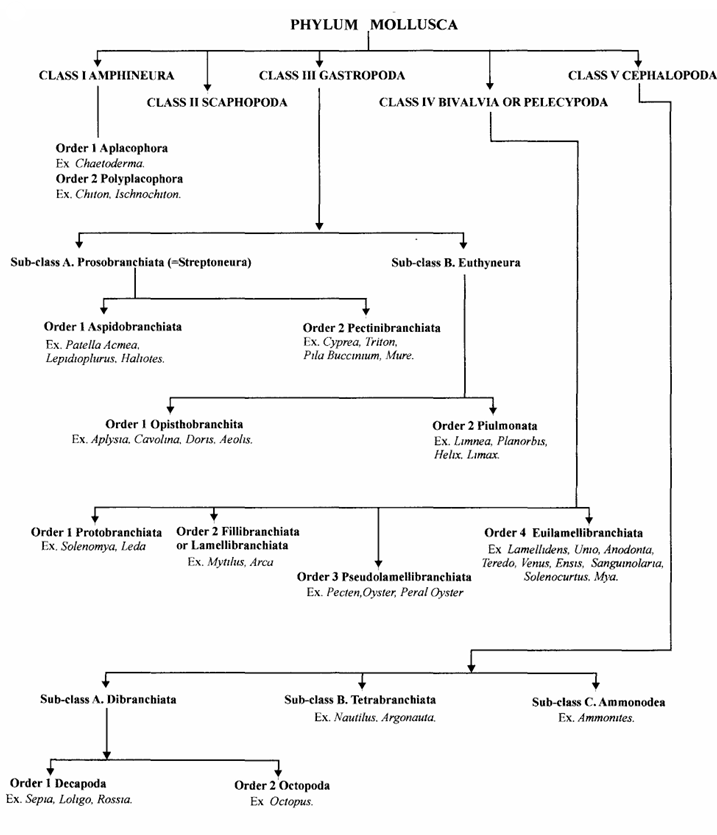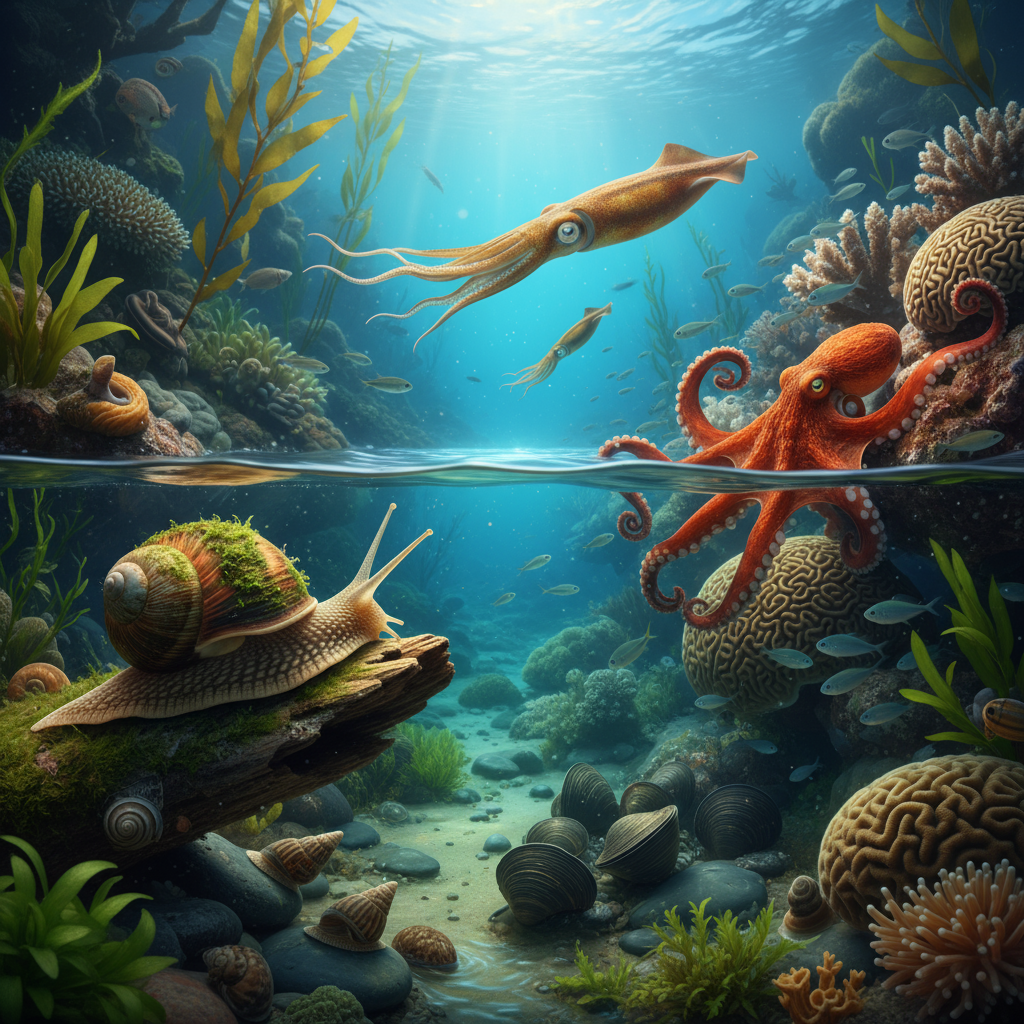Introduction
Phylum Mollusca is one of the largest and most diverse groups in the animal kingdom, comprising over 85,000 recognized species and potentially many more undiscovered ones. The term “Mollusca” comes from the Latin word mollis, meaning soft, referring to the soft-bodied nature of these animals. Members of this phylum are known as mollusks or molluscs and are found in a wide range of habitats, from deep oceans and freshwater bodies to terrestrial environments.
Mollusks include well-known animals such as snails, clams, squids, and octopuses. Despite their diversity in form and function, mollusks share several common anatomical and physiological features that define the phylum. This article explores the general characteristics, classification, body structure, habitat, and ecological and economic significance of Phylum Mollusca.

General Characteristics of Mollusca
Mollusks exhibit a wide array of shapes and sizes, but they share several defining characteristics:
1. Body Structure
The body of a mollusk is generally divided into three main parts:
- Head-foot: Involved in sensory perception and locomotion.
- Visceral mass: Contains most of the internal organs, including those related to digestion, excretion, and reproduction.
- Mantle: A specialized tissue that secretes the shell (if present) and also encloses the mantle cavity, which often houses the gills.
2. Symmetry and Body Plan
- Mollusks are bilaterally symmetrical.
- They exhibit a coelomate body plan (true body cavity).
- The body is unsegmented, except in some primitive mollusks like chitons.
3. Shell
- Most mollusks possess a calcareous external shell for protection, although some, like octopuses, lack shells entirely.
- The shell is secreted by the mantle and is typically composed of calcium carbonate.
4. Circulatory System
- Mollusks may have open or closed circulatory systems.
- Bivalves and gastropods typically have an open circulatory system, while cephalopods have a closed one for greater efficiency.
5. Respiration
- Respiration occurs through gills (ctenidia) or through the body surface in some terrestrial species.
- In aquatic mollusks, gills are housed within the mantle cavity.
6. Excretion
- Excretion is carried out by nephridia, which function similarly to kidneys.
7. Nervous System
- Mollusks have a simple to highly complex nervous system.
- Cephalopods have the most advanced nervous systems among invertebrates, capable of complex behaviors and learning.
8. Reproduction
- Mollusks exhibit sexual reproduction.
- Some are dioecious (separate sexes), while others are hermaphroditic.
- Fertilization can be internal or external depending on the species.
Classification of Mollusca
Mollusks are divided into several classes based on differences in shell structure, body organization, and mode of life. The major classes include:
1. Class Gastropoda
- Examples: Snails, slugs, whelks.
- Features:
- Largest class within Mollusca.
- Undergo torsion during development, which twists the body and brings the mantle cavity to the front.
- Usually have a coiled shell (except in slugs).
- Mostly herbivorous, but some are predatory.
2. Class Bivalvia (Pelecypoda)
- Examples: Clams, oysters, mussels, scallops.
- Features:
- Body enclosed within a two-valved shell.
- No distinct head or radula.
- Most are filter feeders.
- Important ecologically and economically as seafood.
3. Class Cephalopoda
- Examples: Squid, octopus, cuttlefish, nautilus.
- Features:
- Highly developed head and sensory organs.
- Closed circulatory system.
- Tentacles and arms for prey capture.
- Capable of rapid movement using jet propulsion.
- Known for intelligence and camouflage abilities.
4. Class Polyplacophora
- Examples: Chitons.
- Features:
- Dorsal shell composed of eight plates.
- Found on rocks in intertidal zones.
- Strong foot for attachment.
5. Class Scaphopoda
- Examples: Tusk shells.
- Features:
- Tubular, elongated shells open at both ends.
- Burrow in the seafloor.
- Use tentacle-like structures called captacula to capture food.
6. Class Monoplacophora
- Features:
- Primitive mollusks with a simple, cap-like shell.
- Exhibit some features of segmented animals.
- Mostly deep-sea dwellers.
7. Class Aplacophora
- Features:
- Shell-less, worm-like mollusks.
- Live in deep-sea environments.
- Covered with calcareous spicules.

Habitat and Distribution
Mollusks are incredibly diverse in their habitats. They are found in:
- Marine environments: The vast majority of mollusks are marine, from shallow reefs to deep-sea trenches.
- Freshwater bodies: Many bivalves and gastropods inhabit lakes, rivers, and streams.
- Terrestrial regions: Some gastropods like snails and slugs are adapted to live on land, especially in moist environments.
Their adaptability allows mollusks to occupy ecological niches across various climatic and geographical conditions.
Feeding and Nutrition
Feeding strategies in mollusks vary greatly:
- Herbivores (e.g., many gastropods): Use a radula to scrape algae or plant material.
- Filter feeders (e.g., bivalves): Draw water through their gills to extract plankton.
- Carnivores (e.g., cephalopods): Hunt prey using tentacles and a beak-like radula.
- Detritivores: Some mollusks feed on decomposing organic matter.
The radula, a unique rasping organ found in most mollusks, is a key adaptation for feeding.
Economic and Ecological Importance
1. Ecological Role
- Bioindicators: Mollusks are sensitive to environmental changes, making them useful in monitoring ecosystem health.
- Food web: They are a crucial part of aquatic food chains, serving as prey for many animals.
- Sediment stability: Bivalves help stabilize sediments and improve water quality through filtration.
2. Economic Value
- Seafood industry: Clams, oysters, squids, and scallops are commercially harvested around the world.
- Pearl industry: Oysters (mainly Pinctada species) produce pearls, a valuable gemstone.
- Shells: Used in jewelry, decoration, and as currency in some cultures.
- Biological research: Cephalopods, especially octopuses, are studied for their nervous system and behavior.
- Agriculture: Mollusk shells are sometimes used as a source of lime or calcium for soil treatment.
Adaptations and Evolutionary Significance
Mollusks have evolved various adaptations to survive in diverse environments:
- Camouflage and mimicry in cephalopods.
- Burrowing and anchoring abilities in bivalves.
- Coiling and shell modifications in gastropods to reduce predation and conserve moisture.
- Jet propulsion in cephalopods for rapid escape from predators.
Fossil evidence suggests that mollusks have been present since the Cambrian period, making them one of the oldest known invertebrate groups. Their evolution has played a significant role in the development of marine ecosystems.
Threats and Conservation
Many mollusk species are under threat due to:
- Habitat destruction from coastal development and pollution.
- Overharvesting for food and ornamental purposes.
- Climate change and ocean acidification affecting shell formation.
- Invasive species displacing native mollusk populations.
Conservation efforts include habitat restoration, sustainable harvesting practices, and captive breeding programs.
Conclusion
Phylum Mollusca represents an incredible array of life forms with unique adaptations and vital roles in ecosystems across the planet. From the intelligent octopus to the humble garden snail, mollusks are not only fascinating in their biological diversity but also immensely important ecologically and economically. Continued research and conservation are crucial to preserve the biodiversity and ecological balance that mollusks help maintain in marine and terrestrial environments alike.
References
- Encyclopaedia Britannica – “Mollusk”
Definition, classification, and general biology of Mollusca.
Link: https://www.britannica.com/animal/mollusk (Encyclopedia Britannica) - Encyclopaedia Britannica – “Classification and economic importance of mollusks”
Details on the different classes and economic roles of mollusks.
Link: https://www.britannica.com/summary/mollusk (Encyclopedia Britannica) - UCMP Berkeley – The Mollusca
Overview of morphology, lifestyle, habitat, and evolutionary history.
Link: https://ucmp.berkeley.edu/taxa/inverts/mollusca/mollusca.php (UC Museum of Paleontology) - Aakash Educational Services Limited (AESL) – “Phylum Mollusca: Characteristics, Classification & Importance”
Indian academic resource with good summaries of structure, reproduction, and classification.
Link: https://www.aakash.ac.in/important-concepts/biology/phylu-mollusca (Aakash Institute) - ScienceDirect Topics – “Mollusca”
Scholarly content on the anatomy, physiology, and diversity.
Link: https://www.sciencedirect.com/topics/medicine-and-dentistry/mollusca (ScienceDirect)

Pingback: Chiton or Ischnochiton | Zoologyverse | 2025
Pingback: Chaetoderma | Zoologyverse | 2025
Pingback: Dentalium | Zoologyverse | 2025
Pingback: Fissurella | Zoologyverse | 2025
Pingback: Pila globosa (Apple Snail) | Zoologyverse | 2025
Pingback: Haliotis | Zoologyverse | 2025
Pingback: Aplysia | Zoologyverse | 2025
Pingback: Aeolis | Zoologyverse | 2025
Pingback: Planorbis (ram’s horn snails) | Zoologyverse | 2025
Pingback: Limax | Zoologyverse | 2025
Pingback: Mytilus | Zoologyverse | 2025
Pingback: Unio | Zoologyverse | 2025